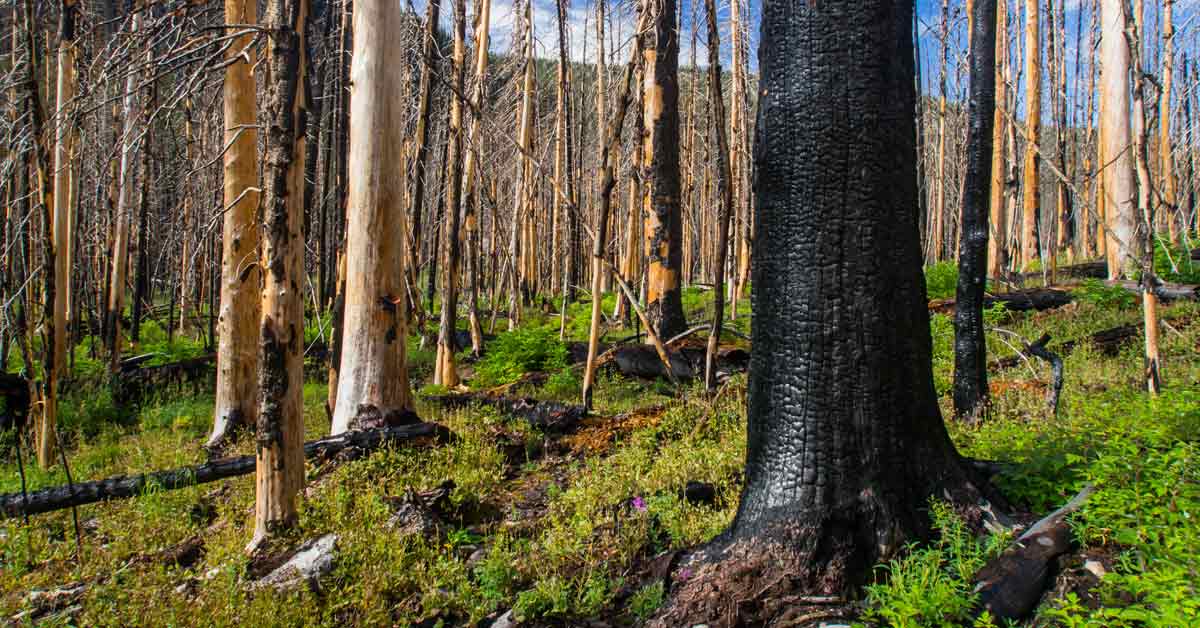5 min read
What Can We Learn from a Record-Setting 2023 Canadian Wildfire Season?
 Harvey Greer
:
Oct 25, 2023 12:00:00 AM
Harvey Greer
:
Oct 25, 2023 12:00:00 AM

Canada’s wildfire season looks to be finally drawing to a close for 2023. While the complete total of affected areas has yet to be 100% determined, what we already know is staggering.
What sorts of things can we learn from what has happened this year in Canada? And how can this knowledge, coupled with the right data, help your business prepare for future climate events like this?
A Record No One Wants to Break
There’s no doubt that this year’s amount of burned forestlands was significant. When comparing the numbers, however, it’s probably worse than many people realize.
Current reports from the Canadian Interagency Forest Fire Centre (CIFFC) truly set the scope of how enormously different this year was:

2023 data shows the total amount of burned hectares at 18,496,051. This amount is…
- … 250% higher than the previous burn year record (1995).
- … nearly the same amount of damage as wildfires across 2015-2022 combined.
- … over 8 times the national wildfire average.
To put this number into perspective, the second-highest burn amount since the CIFFC began tracking was in 1995 at 7,105,998 burned hectares. At the time, this was seen as an all-hands-on-deck crisis stemming from unusually high lightning activity.
2023 numbers blow this previous record-high national crisis heartily out of the water in terms of volume of destruction. The amount is more than just another unusually high fluke. It is a clear indicator of how human-caused climate change is already impacting our ecosystems.
A Climate Event Extending Far Beyond Canadian Borders
For many across Canada and the US, the presence of wildfire smoke was a common companion throughout the summer months. This was especially apparent in the northeast US where cities were met with a cough-inducing reminder of the consequences that stem from immense fire events.
The misery of US citizens was only the tip of the iceberg, however. Wildfire smoke could be found globally, with detection as far-reaching as Norway. With the range of health risks and effects of smoke particulates looming over us, we should all be paying attention.
Canada Becomes a “Super-Emitter” of Atmospheric CO2
From the standpoint of sustainability, Canadian wilderness has long been a carbon sink thanks to its immense area. But this season’s wildfires have flipped the script on its carbon output.
The amount of CO2 released now classifies Canada as a “super-emitter.” The burnt trees output an estimated 2.2 billion tons of atmospheric carbon.
What does this amount look like in the grand scheme of things? As an example, analyses from the 1990s show about 175 million tons of carbon capture in Canadian forests. The 2023 carbon output, in just one year, has undone those carbon savings tenfold.
Related: Old vs. Young Forests: Examining CO2 Storage and Wildfire Risk
The current state of global temperature increases means that we will also experience an increase in major climate events such as this one. As a result, we will also see more instances where smoke emissions undo the years of carbon conservation, we’ve worked so hard to achieve.
What Happens Next? Lessons Learned from the Wildfires
In moments like this, it often seems like we are collectively helpless in stopping the onslaught of negative climate effects in our world. However, this couldn’t be further from the truth.
The actions we take now will have a net positive impact on what happens in the future. Our collective goal right now is to dramatically slow emissions—thereby also slowing the ferocity of global weather events like this wildfire crisis.
Some reflection on what has happened this year will prove helpful. After assessing the numbers and scope of this climate event, what sorts of lessons can we draw from what happened in Canada this year?
1. The Crisis is Here for Everyone, Across Oceans and Beyond Borders
New Yorkers faced mouthfuls of smoky air that persisted for weeks. Michiganders struggled with visibility on the Great Lakes. Even states like South Carolina had air quality alerts due to the wildfire smoke.
And these were only the US reports.
The extensive range of wildfire smoke reminded us that climate events like this are never limited to one country—or even one region. We all feel the effects of the increasing strain our weather systems endure.
Accordingly, we need to address these issues from a broader global perspective to mitigate the negative effects.
2. This is a Global Health Crisis as Much as an Environmental One
Wildfire smoke isn’t just an inconvenience that interrupts your views of the lake. Breathing that smoky air can be detrimental from a health perspective, too.
According to the American Lung Association, particle pollution from wildfire smoke brings a range of negative health outcomes:
- Coughing
- Wheezing
- Colds and flu
- Bronchitis
- Asthma reactions
- Potentially triggering heart attacks and strokes in severe cases
The unprecedented scope of Canada’s wildfire season is not a fluke. It’s an early warning shot of the major weather events we’ll start seeing regularly.
Heeding this warning and taking proactive steps now will prevent a host of health ailments in world populations. We need to address and pursue solutions from a global health standpoint just as much as we do from an environmental one.
3. Economic Effects Extend Far Past Global Wood Markets
Canada’s economic footprint will certainly feel the pinch of this year’s wildfire destruction—particularly in the forestry sector. But we’ll see these adverse effects far beyond Canadian forests and into the global economy.
Ecological disruptions in Canada have already seriously affected softwood lumber supply. Pine beetle infestation destroyed a solid portion of British Columbia’s stock over the last decade. Coupled with decreased lumber mill production and this year’s wildfires, the country’s lumber supply has dwindled.
From an economic standpoint, the decrease in Canadian supply has already caused shifts in global wood markets. According to Hakan Ekstrom, ResourceWise’s Director of International Forests Sector, Canadian wood production has dropped 25% over the last 5 years. Total lumber output now sits 40% lower than it did at its peak 20 years ago.
This means that many markets that relied on Canadian lumber must seek it out from alternative sources. The change is most evident in the US as the country’s wood usage exceeded domestic supply with a 30% gap. With Canada now unable to accommodate this demand, European producers have stepped in to cover it.
Download a free Market Insights report to learn more about Canadian wood prices and market shifts.
The supply disruptions in Canada extend into several other economic sectors such as manufacturing, industrial, home construction, and more. But it is the risk, and uncertain chance of ongoing disruptions, that can lead to global market instability.
The threat of wildfires is increasing in forest stands throughout the world. What if wildfire seasons worsen in Canada? What happens if European supply is next to fall from a terrible wildfire season?
Instability in the resources that drive economic factors can disrupt the whole system. And that’s bad news no matter what business you’re in.
4. Mitigation in Wildfire Reduction and Prevention is Critical
Finding solutions to wildfire risks starts on the ground in the forest. We’ve covered the topic of responsible forest management before. But now more than ever, understanding the importance of this practice is imperative.
Related: Putting Forests to Work: How Responsible Forestry Helps Sustainability
Forest management encompasses a variety of tactics to reduce the severity and potential of wildfires. Common practices include forest thinning, strategic harvesting, and controlled burns in some circumstances.
The bottom line is that the intensity of wildfires we’re seeing today has come thanks to human-caused climate change. Therefore, we will also need human intervention to protect the forests we have. This is true whether the forests are for commercial purposes or natural ones.
We can’t leave forests in danger zones untouched any longer because of the ever-increasing dangers of wildfires. Identifying the risk areas is key. But intervening and helping to strengthen the forests against the burns is just as important.
To make the shift into a sustainable world, we need our forests now more than ever. Because of this, we must do what we can to protect them from the dangers that lie ahead.
How Can My Business Prepare for the Unknown?
Ambiguity and uncertainty are the poison daggers to almost every business's forecasting and planning. After all, how can you prepare for something you may not even see coming?
The answer to this question comes down to data. The right data, combined with the right insights and expertise, can keep your business informed. Through this process, you can prepare yourself for whatever challenges you may face.
One of the biggest obstacles facing businesses today is the transition to a carbon-free future. The movement to renewables is now a global priority. If you haven’t started preparing for this transition, you’re already behind.
Prima CarbonZero from ResourceWise can help. Our platform provides a wealth of data and insights all aimed at guiding your business to decarbonization.

Our market data on renewables brings together the tools and information you need to understand the emerging biofuels market. Through this knowledge, you can develop a successful plan to transition operations, investments, and resource usage into a sustainable future.





